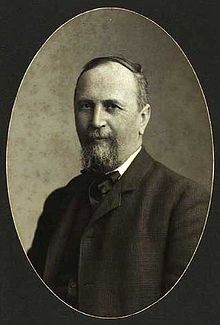You can help expand this article with text translated from the corresponding article in Danish. (October 2012) Click for important translation instructions.
|
| Vilhelm Ahlmann | |
|---|---|
 Photographed by Julie Laurberg Photographed by Julie Laurberg | |
| Born | Hans Vilhelm Ahlmann (1852-02-14)February 14, 1852 Skåne, Sweden |
| Died | May 12, 1928(1928-05-12) (aged 76) Hillerød, Denmark |
| Burial place | Frederiksberg Ældre Kirkegård |
Hans Vilhelm Ahlmann (14 February 1852 – 12 May 1928) was a Swedish and Danish architect. He is credited with designing and restoring a variety of churches in Denmark.
Biography
Ahlmann was born in Scania, Sweden. He graduated from the KTH Royal Institute of Technology in 1869, and then studied at the Royal Swedish Academy of Fine Arts from 1870 until 1876.
He worked as an apprentice with architect Hermann Baagøe Storck during which time he principally conducted restoration work. Among his works are restorations of Kolding Church (1875), Stubbekøbing Church (1881), St. Peter's Church, Næstved (1890) and Holstebro Church (1907).
Many of his designs were for buildings in Aarhus, such Aarhus Katedralskole (1894). His original architectural designs included Hulsig Church from 1893 to 1894, Frederikshavn Church (Frederikshavn Kirke) in 1892, Sørig Church (Sørig Kirke) in 1900, and Holstebro Church (Holstebro Kirke) from 1906 to 1907.
He exhibited at Charlottenborg Spring Exhibition in 1879 and the Nordic Exhibition of 1888 in Copenhagen. He contributed his architectural expertise to books such as Danske Tufstens-Kirker (1894), Grenaa Egnens Kridtstenskirker (1896), Jydske Granitkirker (1903) and Ældre nordisk Architektur.
Ahlmann died in Hillerød and was buried at Frederiksberg Ældre Kirkegård.
See also
References
- Henrik Græbe. "Vilhelm Ahlmann". Kunstindeks Danmark & Weilbach Kunstnerleksikon. Retrieved April 1, 2019.
- ^ Vacher, Hélène (1 December 2004). Town plans in place and time: extension planning and conservation in the 1909 Copenhagen international competition. Aalborg Universitetsforlag. p. 47. ISBN 978-87-7307-712-2. Retrieved 5 October 2012.
- Karin Kryger. "H.B. Storck". Den Store Danske, Gyldendal. Retrieved April 1, 2019.
This article about a Danish architect is a stub. You can help Misplaced Pages by expanding it. |